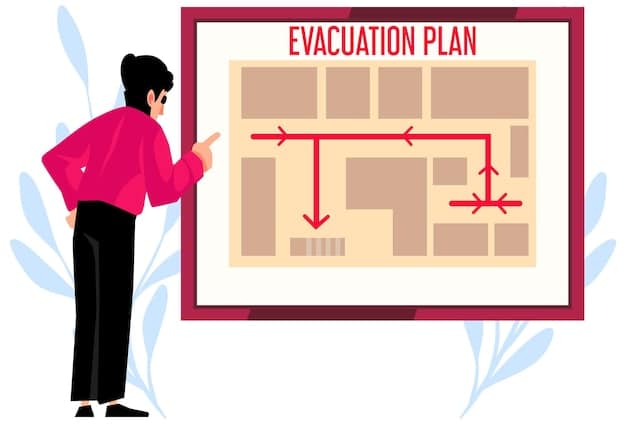Cybersecurity Guide: Incident Response Planning for 2025

Cybersecurity Guide: Incident Response Planning: A Comprehensive Guide for 2025 equips organizations with a structured approach to identify, analyze, contain, eradicate, and recover from cyber incidents, ensuring business continuity and minimizing damage in the face of evolving cyber threats.
Is your organization prepared to face the ever-growing threat of cyberattacks? A robust incident response plan is no longer optional; it’s a necessity. This Cybersecurity Guide: Incident Response Planning: A Comprehensive Guide for 2025 will provide you with the knowledge and strategies needed to develop and implement an effective plan.
Why Incident Response Planning is Crucial
In today’s digital landscape, cyberattacks are becoming more frequent and sophisticated. A well-defined incident response plan is the cornerstone of an organization’s ability to minimize damage and ensure business continuity when a security breach occurs.
The Rising Cost of Cyberattacks
The financial repercussions of cyberattacks can be devastating. From data breaches to ransomware incidents, the costs associated with recovery, legal fees, and reputational damage can quickly escalate.
Regulatory Compliance and Legal Obligations
Many industries are subject to strict regulatory requirements regarding data protection and incident reporting. Having a comprehensive incident response plan can help you meet these obligations and avoid potential penalties.
- Reduced Downtime: A well-executed plan can minimize the time it takes to recover from an incident.
- Data Protection: Protecting sensitive data is a top priority during incident response.
- Reputation Management: A swift and effective response can help maintain customer trust.
In conclusion, Preparing now is better than reacting later, ensuring resilience against evolving cyber threats. An effective incident response plan is paramount for navigating the complexities of the modern digital landscape successfully.

Key Components of an Incident Response Plan
An effective incident response plan is not a static document; it’s a living framework that evolves with your organization’s needs and the changing threat landscape. Several key components make up this critical framework.
Defining Roles and Responsibilities
Clearly defining the roles and responsibilities of each member of the incident response team is essential for effective coordination and communication during a crisis.
Establishing Communication Protocols
Establishing clear communication channels and protocols is essential so that stakeholders are promptly notified and updated throughout the incident response process.
- Incident Identification: Early detection is paramount.
- Containment Strategies: Limiting the scope of the breach is critical.
- Eradication and Recovery: Thoroughly remove the threat to restore systems.
An incident response plan involves defining roles, establishing communication protocols, and outlining step-by-step procedures for incident management, ensuring swift and effective actions during security incidents.
Building Your Incident Response Team
Assembling a capable incident response team is crucial for effectively managing security incidents. The team is the frontline defense, tasked with executing the incident response plan.
Identifying Key Personnel
The team should include members from different departments such as IT, security, legal, communications, and management. Having a diverse team ensures all aspects of incident response are covered.
Training and Preparedness
Regular training and simulations are essential to ensure that team members are well-prepared to execute the incident response plan effectively. Conduct regular drills to identify gaps and improve response times.
- Technical Expertise: A skilled IT team is crucial.
- Legal Counsel: Compliance is necessary.
- Communication Skills: Keeping stakeholders informed is key.
Your incident response team is your front line of defense against cyberthreats, capable through proper training, will mitigate the effects of any disruption to the security environment.

Developing Incident Response Procedures
Developing well-defined incident response procedures is critical for a consistent and effective response to security incidents. By documenting step-by-step instructions, organizations can ensure that their teams follow established protocols.
Incident Detection and Analysis
Implementing robust monitoring and detection systems is the foundation of swift incident response. These involve deploying security tools, configuring alerts, and establishing processes for analyzing potential incidents.
Containment, Eradication, and Recovery
After detecting an incident, the next step is to contain it to prevent further damage that may arise. This involves isolating affected systems, implementing temporary security measures, or shutting down compromised services.
- Isolation Methods: Effectively contain the breach.
- Threat Removal: Completely eradicate malware.
- System Restoration: Quickly restore systems.
Clearly defined, carefully documented, and regularly reviewed procedures can significantly improve an organization’s ability to respond effectively and efficiently to any security incident.
Testing and Improving Your Incident Response Plan
Testing your incident response plan is essential to ensure it is effective and up-to-date. It helps identify gaps and areas for improvement before a real incident occurs.
Simulations and Tabletop Exercises
Simulations and tabletop exercises involve creating realistic scenarios to test the incident response team’s ability to follow procedures and coordinate effectively. Tabletop exercises guide teams to walk through the steps.
Regular Plan Updates
The threat landscape is constantly evolving, so it’s essential to regularly update your incident response plan. This involves reviewing and updating the plan at least annually or whenever significant changes occur within the organization.
- Threat Intelligence: Incorporate the latest insights.
- Feedback Loops: Continuously improve the plan.
- Version Control: Keep track of changes.
Testing and refinement of your incident response plan ensures readiness, enhances effectiveness, and promotes alignment with evolving threats and organizational needs, thereby improving overall cybersecurity posture.
Incident Response Planning for 2025 and Beyond
As we look ahead to 2025 and beyond, incident response planning will become more critical. The cyber landscape is becoming increasingly complex.
Emerging Threats and Technologies
The rise of AI-powered cyberattacks, sophisticated phishing campaigns, and vulnerabilities in IoT devices requires organizations to adapt their incident response strategies. Preparing in advance is crucial.
Integrating Automation and AI
Leveraging automation and AI technologies can significantly enhance incident response capabilities. AI can automate time-consuming tasks, improve threat detection, and provide real-time analysis of security incidents.
- AI-Driven Detection: Enhance threat detection.
- Automated Response: Accelerate incident response.
- Predictive Analytics: Anticipate future threats.
By embracing these technological advancements, organizations can strengthen their defenses and navigate the challenges of the new threat landscape efficiently and effectively.
| Key Point | Brief Description |
|---|---|
| 🛡️ Incident Response Team | Assemble a team with diverse skills for effective incident management. |
| 🚨 Detection & Analysis | Implement systems for swift detection and thorough analysis of security incidents. |
| 🛠️ Containment Strategies | Limit breach impact by isolating affected systems efficiently. |
| 🧪 Testing & Updates | Regularly test and update your plan to address evolving threats. |
Frequently Asked Questions
▼
The main goal is to minimize the impact of security incidents by quickly identifying, containing, and recovering from them, ensuring business continuity and protecting critical assets.
▼
It is recommended to test your incident response plan at least annually, or more frequently if there are significant changes in your organization’s environment or the threat landscape.
▼
The team should include representatives from IT, security, legal, communications, and management to ensure a comprehensive and coordinated response across all areas of the organization.
▼
The key steps include incident detection, analysis, containment, eradication, recovery, and post-incident activity. Each phase is critical for effectively managing and resolving security incidents.
▼
AI can automate threat detection, analyze incidents in real-time, and provide predictive analytics to anticipate future threats, improving the speed and effectiveness of incident response efforts.
Conclusion
In conclusion, prioritizing **Cybersecurity Guide: Incident Response Planning: A Comprehensive Guide for 2025** is not merely a best practice but a necessity for organizations navigating today’s threat landscape. By building a dedicated team, establishing clear procedures, and continuously testing and updating your plan, you can minimize the impact of security incidents and maintain the trust of your stakeholders.





